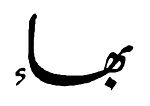Baháʼí Symbols
There are several symbols used to express identification with the Baháʼí Faith: the nine-pointed star, a calligraphy known as the Greatest Name, the Ringstone Symbol, or a five-pointed star.
This article may rely excessively on sources too closely associated with the subject, potentially preventing the article from being verifiable and neutral. (February 2021) |

Nine-pointed star

According to the Abjad system of isopsephy, the word Baháʼ has a numerical equivalence of 9, and thus there is frequent use of the number 9 in Baháʼí symbols. The most commonly used symbol connected to the number 9 is the nine-pointed star,  ; there is no particular design of the nine-pointed star that is used more often than others. While the star is not a part of the teachings of the Baháʼí Faith, it is commonly used as an emblem representing "9", because of the association of number 9 with perfection, unity and Baháʼ.
; there is no particular design of the nine-pointed star that is used more often than others. While the star is not a part of the teachings of the Baháʼí Faith, it is commonly used as an emblem representing "9", because of the association of number 9 with perfection, unity and Baháʼ.
The number 9 also comes up several times in Baháʼí history and teachings. On the significance of the number 9, Shoghi Effendi wrote:
Concerning the number nine: the Baháʼí's reverence this for two reasons, first because it is considered by those interested in numbers as the sign of perfection. The second consideration, which is the more important one, is that it is the numerical value of the word "Bahá"[.]
Besides these two significances the number nine has no other meaning. It is, however, enough to make the Baháʼís use it when an arbitrary number is to be chosen.
Its use on gravestone markers was approved by Shoghi Effendi, then head of the religion, in 1944.
On 13 September 2022, the symbol was added to Unicode as U+1F7D9 🟙 NINE POINTED WHITE STAR.
Five-pointed star
The five-pointed star, or haykal (Arabic: temple) is a symbol of the Baháʼí Faith as mentioned by Shoghi Effendi, head of the Baháʼí Faith in the first half of the 20th century: "Strictly speaking the 5-pointed star is the symbol of our Faith, as used by the Báb and explained by Him." The five-pointed star has been used as the outline of special letters or tablets by both the Báb and Baháʼu'lláh.
Haykal is a loan word from the Hebrew word hēyḵāl, which means temple and specifically Solomon's Temple in Jerusalem. In Arabic, the word also means the body or form of something, particularly the human body. In the Baháʼí tradition, the haykal was established by the Báb — and represents the human body as a head, two hands, and two feet. The Báb wrote many letters, tablets, prayers and more in the shape of a five-pointed star, including some that included many derivatives of the word Baháʼ (see below).
Baháʼu'lláh wrote the Súriy-i-Haykal (Tablet of the Temple) in the shape of a five-pointed star. While the meaning of temple remains present, the haykal is used mainly to mean the human body, but particularly the body of the Manifestation of God — a messenger from God — and the person of Baháʼu'lláh himself. In the Tablet, the haykal is also used to refer to the word of God, which is revealed by the Manifestations of God. He also says in the same Tablet:
"O Living Temple! We have, in very truth,...ordained Thee to be the emblem of My Cause betwixt the heavens and the earth..."
- Haykal by the Báb written in his own hand.
- An unidentified tablet in the Báb's handwriting.
- An unidentified tablet in the Báb's handwriting.
The Greatest Name

In Islam, God has 99 names, and in some Muslim traditions it is believed that there is a special hidden 100th name, which is the greatest. In the Baháʼí Faith, this 'Greatest Name' is Baháʼ (بهاء), translated as "glory, splendour. Many symbols of the Baháʼí Faith derive their significance from the word Baháʼ. It is the root word used in many other names and phrases including Baháʼí (a follower of Baháʼ), Baháʼu'lláh "Glory of God", ʻAbdu'l-Bahá "Servant of Glory", Yá Baháʼu'l-Abhá "O Thou Glory of the Most Glorious", and Alláh-u-Abhá "God is Most Glorious".

Baháʼu'lláh often referred to Baháʼís in his writings as "the people of Baháʼ". The Báb sent a tablet to Baháʼu'lláh with 360 derivatives of the word Baháʼ. Along with daily prayers, Baháʼís are encouraged to recite the phrase "Alláh-u-Abhá" 95 times in a form of meditation.

The symbol known as Greatest Name is a calligraphic rendering of "Yá Baháʼu'l-Abhá" (Arabic: يا بهاء الأبهى, romanized: Yā bahāʾ al-Abhá, lit. 'most glorious splendour!'), usually translated as "O Thou the Glory of the Most Glorious!"). This rendering was originally drawn by the early Baháʼí calligrapher Mishkín-Qalam, and later adopted by Baháʼís everywhere.
Since the symbol refers more directly to the Name of God and the Manifestation of God than any other symbol in the Baháʼí Faith, it is not generally used casually or to adorn the personal artifacts that are put to common use. The symbol can usually be seen in Baháʼí homes and rings that are produced on a limited scale.
Ringstone symbol


The Ringstone Symbol was designed by ʻAbdu'l-Bahá, and, as its name implies, is the most common symbol found on rings worn by Baháʼís, but it is also used on necklaces, book covers, and paintings. It consists of two stars (haykal) interspersed with a stylized Baháʼ. The lower line is said to represent humanity and the world of creation, the upper line the world of God, and the middle line represents the special station of Manifestation of God and the world of revelation; the vertical line is the primal will or Holy Spirit proceeding from God through the manifestations to humanity. The position of Manifestation of God in this symbol is said to be the linking point to God. The two stars or haykals represent Baháʼu'lláh and the Báb. Together, the relationship between the upper, middle, and vertical lines also constitute what could be regarded as a Baháʼí rendering of the holy trinity, while it is also probably no coincidence that the shape of the symbol bears similarity to the Chinese characters for king 王, Jade Emperor 玉帝, and master 主.
Notes
References
- Baháʼu'lláh (2002) [composed 1868]. The Summons of the Lord of Hosts. Haifa, Israel: Baháʼí World Centre. ISBN 0-85398-976-1.
- Bayat, Mohamad Ghasem (2001). "An Introduction to the Súratu'l-Haykal (Discourse of The Temple)". Lights of Irfan.
- Buck, Christopher (1999). Paradise and Paradigm. SUNY Press. ISBN 9780791497944 – via Baháʼí Library Online.
- Collins, William (1990). "Sacred Mythology and the Baháʼí Faith" (PDF). Journal of Baháʼí Studies. 2 (4): 1–15. doi:10.31581/JBS-2.4.1(1990). Archived from the original (PDF) on 2011-07-18. Retrieved 2016-06-24.
- Effendi, Shoghi (1973). Directives from the Guardian. Hawaii Baháʼí Publishing Trust.
- Faizi, Abu'l-Qasim (1968). Explanation of the Symbol of the Greatest Name. New Delhi: India Baháʼí Publishing Trust – via Baháʼí Library Online.
- Hatcher, John S. (1997). The Ocean of His Words: A Reader's Guide to the Art of Baháʼu'lláh. Wilmette, Illinois, USA: Baháʼí Publishing Trust. ISBN 0-87743-259-7.
- Hornby, Helen, ed. (1983). Lights of Guidance: A Baháʼí Reference File. New Delhi: India Baháʼí Publishing Trust. ISBN 81-85091-46-3 – via Baháʼí Library Online.
- Lambden, Stephen (1993). "The Word Baháʼ: Quintessence of the Greatest Name". Baháʼí Studies Review. 3 (1) – via Baháʼí Library Online.
- MacEoin, Denis (1997). Hinnells, John R. (ed.). A New Handbook of Living Religions. Blackwell Publishers. ISBN 0-631-18275-6.
- Momen, Moojan (2019). "The Star Tablet of the Bab". British Library Blog.
- Rabbani, Ruhiyyih (1984). The Desire of the World: Materials for the Contemplation of God and His Manifestation for This Day. Oxford, UK: George Ronald.
- Riggs, Robert F. (1981). Apocalyspe Unsealed. New York: Philosophical Library. ISBN 0-8022-2367-2.
- Saiedi, Nader (2000). Logos and Civilization - Spirit, History, and Order in the Writings of Baháʼu'lláh. USA: University Press of Maryland and Association for Baha'i Studies. ISBN 1883053609. OL 8685020M.
- Smith, Peter (2000). A concise encyclopedia of the Baháʼí Faith. Oxford: Oneworld Publications. ISBN 1-85168-184-1.
- Taherzadeh, Adib (1984). The Revelation of Baháʼu'lláh, Volume 3: 'Akka, The Early Years 1868-77. Oxford, UK: George Ronald. ISBN 0-85398-144-2.
- Universal House of Justice (1999-01-24). "The Nine-Pointed Star: History and Symbolism". Baháʼí Library Online. Retrieved Sep 14, 2014.
- Walbridge, John (1995), Sacred Acts, Sacred Space, Sacred Time, Oxford: George Ronald, ISBN 0-85398-406-9
External links

- The Art of the Greatest Name
- The Nine-Pointed Star, History and Symbolism - by the Universal House of Justice, 1999
- Story of the Ringstone Symbol
- Greatest Name Song and Poem Site used with permission, a public site
This article uses material from the Wikipedia English article Baháʼí symbols, which is released under the Creative Commons Attribution-ShareAlike 3.0 license ("CC BY-SA 3.0"); additional terms may apply (view authors). Content is available under CC BY-SA 4.0 unless otherwise noted. Images, videos and audio are available under their respective licenses.
®Wikipedia is a registered trademark of the Wiki Foundation, Inc. Wiki English (DUHOCTRUNGQUOC.VN) is an independent company and has no affiliation with Wiki Foundation.


